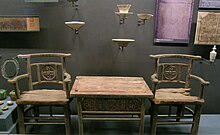







The forms of Chinese furniture evolved along three distinct lineages which date back to 1000 BC:[1] frame and panel, yoke and rack (based on post-and-rail seen in architecture) and bamboo construction techniques. Chinese home furniture evolved independently of Western furniture into many similar forms, including chairs, tables, stools, cupboards, cabinets, beds and sofas. Until about the 10th century CE, the Chinese sat on mats or low platforms using low tables, but then gradually moved to using high tables with chairs.[2]
Chinese furniture is mostly in plain, polished wood, but from at least the Song dynasty, the most luxurious pieces often used lacquer to cover the whole or parts of the visible areas. All the various sub-techniques of Chinese lacquerware can be found on furniture, and became increasingly affordable down the social scale—thus widely used—from about the Ming dynasty onwards. Carved lacquer furniture was, at first, only affordable by the imperial family or the extremely rich, but by the 19th century, it was merely very expensive, and mostly found in smaller pieces or as decorated areas on larger ones. It was especially popular on screens, which were common in China. Lacquer inlaid with mother of pearl was a technique used especially on furniture.[2][3]
Chinese furniture is usually light, whenever possible, anticipating Europe by several centuries in this respect. Practical fittings in metal such as hinges, lock plates, drawer handles and protective plates at edges or feet are used and often given considerable emphasis, but compared to classic European fine furniture, purely decorative metal mounts were rare. From the Qing dynasty, furniture made for export, mostly to Europe, became a distinct style, generally made in rather different shapes to suit the destination markets and highly decorated in lacquer and other techniques.[2]
Early traditional Chinese furniture for sitting or lying on was not often covered with soft material. Not until very late historical periods, were cushions, textiles, and other forms of upholstery incorporated into Chinese furniture, impacted by Western culture. Openwork in carved wood or other techniques is very typical for practical purposes such as chair-backs, and also for decoration. The Ming period is regarded as the "golden age" of Chinese furniture, though very few examples of earlier pieces survive. Ming styles have largely set the style for furniture in traditional Chinese style in subsequent periods, though as in other areas of Chinese art, the 18th and 19th centuries saw increasing prosperity used for sometimes excessively elaborated pieces, as wider groups in society were able to imitate court styles.[2]